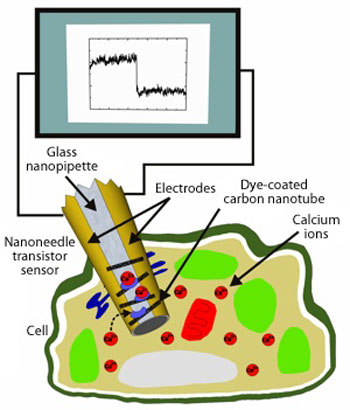| Aug 01, 2011 |
Biosensors: Real-time in-cell calcium detection
|
|
(Nanowerk News) The real-time detection of biomolecules and chemicals has attracted much attention in recent years. Many biosensors provide excellent selectivity, yet most are large compared to the dimensions of individual cells and so cannot be used to detect intracellular molecules. Nanoprobes, on the other hand, are of a suitable size for in-cell sensing, but such nanosensors often suffer from poor selectivity and sensitivity, making them unsuitable for clinical applications. Seunghun Hong and co-workers from Seoul National University, Korea University and Soonchunhyang University in Korea have now developed a carbon nanotube-based sensor that is capable of detecting calcium ions in living cells ("Nanoneedle Transistor-Based Sensors for the Selective Detection of Intracellular Calcium Ions").
|
 |
| Schematic diagram of a nanoneedle transistor sensor for measuring intracellular calcium ion concentration
|
|
Calcium ions are present in many cells and provide a good target for testing nanosensors. Signaling pathways in cells are based on the generation of specific chemical species such as calcium ions at particular times, and being able to selectively measure the presence and levels of such species with high selectivity and sensitivity can provide a snapshot of the current status of a cell.
|
|
The researchers created the nanotube sensor by modifying the sub-micrometer tip of a glass nanopipette so that it functioned as a field-effect transistor, allowing it to detect a change in electrical current in the presence of the target molecule. They achieved this by coating opposite sides of the nanopipette with gold/titanium electrodes, then depositing carbon nanotubes so as to bridge the two contacts (see image). After functionalizing the carbon nanotubes with a fluorescent dye, the nanoneedle sensor generated an electrical and fluorescence signal in response to the presence of calcium ions inside cells at concentrations as low as 100 pM.
|
|
Hong and his colleagues now hope to extend their work beyond the proof-of-concept phase. "As a next step, we will apply our sensors to the measurement of other, more interesting biochemical materials related to the signaling pathways in cells, which should allow us to study the signaling pathways in real time," says Hong. "We plan to improve the reliability of our sensors to a level suitable for clinical applications." The team is confident that reliability concerns can be overcome and are actively pursuing opportunities to develop a device suitable for use in the clinic.
|

